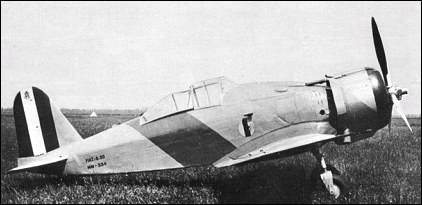|
| Representing the first design essay of
the young technician Giuseppe Gabrielli
with the Fiat company, the Fiat
G.50 fighter was designed in 1935-6
but, although a break from the traditional
biplane formula, offered much
less in operational potential than the
contemporary Hawker Hurricane and
Messerschmitt Bf 109. The prototype
G.50 first flew on 26 February 1937 and
was the first all-metal monoplane with
constant-speed propeller and retractable
landing gear to be evaluated by
the Regia Aeronautica. Named Freccia
(arrow), the G.50 was ordered into
production with the CMASA company
(a subsidiary of Fiat) and 12 of the first
aircraft were sent to Spain for operational
evaluation. Despite the superiority
of the Macchi C.200, it was decided
to go ahead and equip one stormo
and one gruppo with the G.50, and
an initial order for 200 aircraft was
placed. In November 1939 the type
was delivered to the 51° Stormo, and
soon afterwards to the 52° Stormo, and
when Italy entered the war in the following
June 118 Freccias were in service.
In November 1940 48 G.50s of the
51° Stormo moved to Belgium to take
part in the air attacks on the UK;
however, they saw little action, being
principally engaged in 'surveillance'
duties. In September that year the prototype
of a new version, the G.50bis,
had flown, and with improved cockpit
armour and increased fuel this entered
production for eventual service with
five gruppi in North Africa. With a
maximum speed of only 460km/h
and an armament of two
machine-guns, the G.50 was hardly a
match for RAF fighters in the
Mediterranean, yet survived in service
until July 1943. Production eventually
reached 245 G.50 and 421
G.50bis fighters, and 108 of a dualcontrol
two-seat trainer, the G.50B.
G.50s were also supplied to the Croatian
and Finnish air forces.
 | A three-view drawing (972 x 616) |
| Anonymous, 29.06.2022 01:31 Although the G.50 was not the best fighter of its' day, one still cannot help wondering what the Italian Air Force was thinking to have preferred the CR42 over this. reply |
| Barry, 01.09.2016 18:23 Power plant 1 x 870 h.p Fiat A.74 RC38 14 cylinder air cooled radial
Span 36'1" Length 26'3" Height 10'9" Wing area 196 sq ft
Empty weight 4,328 lb Max take off weight 5,295 lb
Max speed 292 mph at 16,400 ft
Range 276 miles Service ceiling 35,105 ft
Armament 2 x 12.7 mm Breda-SAFAT machine guns reply | | Göran Bruun, e-mail, 16.07.2016 18:31 The closed cockpit was a disadvantage causing bad visibility. The closed cockpit was removed in Finland. It was not uncomfortable flying The Fiat G. 50 during wintertime. You could get warm air blowing into the cockpit. My father Carl-Erik Bruun flew the Fiat G. 50 in Finnish Air Force against Sovjet during The WW II. reply | | Klaatu83, e-mail, 26.08.2012 05:06 The photo shows one of the early G-50 fighters with a fully-enclosed cockpit. However, the Italian fighter pilots apparently preferred to fly with the wind in their hair, so most G-50s were built with an old-fashioned open cockpit, as depicted in the three-view drawing. They must have been awfully uncomfortable flying over Finland in the wintertime! reply | |
| | Barry, 02.12.2010 17:49 I am unable to say exactly when this aircraft was first delivered to the Regia Aeronautica, but most sorces say early 1938. reply | | Fernando Diaz, e-mail, 05.01.2007 06:54 Your information is very interesting. Do you know the exact delivery date to the Regia Aeronautica of operational G.50? reply |
|
Do you have any comments?
|
| 
COMPANY
PROFILE
All the World's Rotorcraft
|








Stay anonymous or better still study the history on the subject.
reply